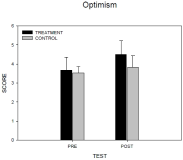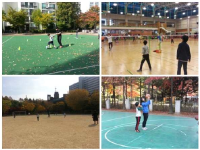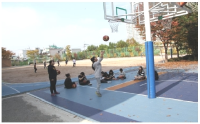PURPOSE This research explores the underlying mechanism that determines how people perceive their goal progress and its relation with their motivation and self-efficacy. METHODS Three hundred and sixty Koreans who participated in an online survey were given salient individual exercise goals (11 workouts), and they reported their self-efficacy, goal progress perception, and motivation. We conducted dummy variable multiple regression analysis (2 [absolute progress-low (27%) vs. high (73%)] X 2 [categorization vs. no-categorization]) and multiple moderated mediation analysis based on Process Model 7 and 21 (Hayes, 2017). RESULTS The findings showed significant interaction between categorization and absolute progress on progress perception. In low progress condition, the categorization group perceived more progress than no categorization group and contrary effect in high progress condition. For motivation, in low progress condition, categorization group was more motivated than no categorization group, and inverse effect in high progress condition. Moreover, there was no direct effect, but only low self-efficacy group played the moderating role between perceived progress and motivation in conditional indirect effect. Lastly, the result indicated significant multiple moderated mediation effect. CONCLUSIONS This research theoretically contributes to the domains of categorization and motivation. Sport marketers can utilize categorization as a strategy by breaking down yearly memberships into monthly categories based on consumers perceptions. Future research can include subsequent motivation after a superordinate goal is completed.

Purpose The present study explores educational values of professional coaches from perspectives as educators while they are giving the players sports coaching. Since free agent system was introduced in 1999 at Korean Baseball Organization(KBO) league, the socio-economical differences between players and coaches are getting bigger and bigger. In this situation, professional coaches tend to have more difficulties in interacting with the players. The study focuses on looking into professional coaches' educational agony and reward. Also, it highlights their educational values as educators rather than coaches. Methods Two professional baseball coaches and a TV commentator participated in the study: all past professional players, and professional coaches for more than 10 years. The researchers collected data through semi-structured in-depth interviews; each participant was interviewed three times. The researchers recorded and transcribed all of the interviews; then, the researchers reread the interview transcripts and inductively produced codes for themes whenever emergent codes appeared. Verbatim quotations from the interviews are excerpted in the present research report. Results The findings indicate that, first, the participants are all highly motivated in giving lessons to the players. They all helped the players overcome the difficulties and be good players. They emphasized the importances of endeavors and attitudes during their lessons to be well-received by the players. Second, the participants agreed that good coaches should have the ability to find the potentials of the players and have personality to gain the players' trust. They always have to work and study hard to keep expertises. Conclusions This study argues that the participants are playing their roles in a sport coaching area not only as coaches, but also as educators.

PURPOSE The purpose of this study is to explore the effects of the student-athlete and student peer mentoring program as a collegiate class. METHODS The peer mentoring program, conducted at A University in the first semester of the 2023 school year, was evaluated using practical action research (Zuber-Skeritt, 1996). RESULTS In the introduction stage, ‘relative and absolute evaluation’, ‘member ratio’, and ‘definition of professor role’ were categorized as challenge issues. In the progress stage, ‘de-formalized lecture method’, ‘student athlete’s coaching experience’, and ‘student’s experience of football culture’ were discovered as possibilities, while ‘vacancy and absence of mentor-mentee’, ‘limited group activities and limitations of team sports’, and ‘lack of objective evaluation’ required improvement. At the end stage, student-athletes experienced changes in values such as self-identity, football, and human relationships, as well as quantitative and qualitative changes in sports participation. CONCLUSIONS This study confirmed the potential of the peer mentoring program as a collegiate class as well as its practical significance for guaranteeing student-athletes' learning rights and for forming sports culture on collegiate campuses.
PURPOSE The purpose of this study was to compare the dynamic postural control of youth athletes with and without a history of lateral ankle sprains. METHODS Twenty-eight youth athletes (14 lateral ankle sprain, 14 healthy control) participated in this study. All participants answered the Foot and Ankle Ability Measure questionnaire and were subject to the Star Excursion Balance Test (SEBT) for dynamic postural control evaluation to collect the joint angles of the lower extremity, a center of pressure (COP) path, and COP velocity. Independent sample t-test or Mann-Whitney U-test were performed to analyze the difference between the groups. RESULTS The lateral ankle sprain group (LAS) was found to have a long experience in participating in sports, and low Foot and Ankle Ability Measure scores were identified when compared to the healthy control (CON; p<0.05). LAS was observed with a short reach distance, less hip flexion, and dorsiflexion angles during the anterior direction of SEBT when compared to CON (p<0.05). Furthermore, LAS showed a slower anteroposterior and mediolateral center of pressure velocities in the posteromedial aspect of SEBT and a slower anteroposterior COP velocity in the posterolateral aspect of SEBT when compared to that of CON (p<0.05). There were no differences between the groups with respect to the other variables (p>0.05). CONCLUSIONS Based on these results, decreased anterior reach distance of SEBT may be affected by changing the dynamic posture control strategy of the lower extremity joint on the sagittal plane in LAS.
PURPOSE This study aimed to apply a capacity building program to sport life skill leaders and to provide cases of this process. METHODS The study participants included four leaders (male=2, female= 2, Mage=37.5) who were managing a sport life skills program at a university. They participated in a capacity building program, which consisted of (a) understanding (leader seminar), (b) application (managing the sport life skills program), and (c) evaluation (leader’s self-reflection), which were conducted in eight sessions. Four leaders conducted self-evaluations using program quality assessment (PQA) during every session, and quantitative and qualitative data were collected. Qualitative data were derived using a cross-case analysis, and quantitative data were used for calculating the effect size after performing the paired t-test. RESULTS Analyzing the reported cases of sport life skill leaders, the use value of the capacity building program was identified. Furthermore, the cases reported by the four leaders enabled observation of how the leader’s capabilities were strengthened. In the paired t-test, the effect size of physical and psychological safety, appropriate structure, supportive relationship, opportunities to belong, support for efficacy mattering, opportunities for life skill building, excluding integration of family, school, and community effort, were all significant. All effect sizes were found to have “very large effects.” CONCLUSIONS The capacity building program played a positive role in strengthening the leaders’ life skill coaching capabilities. These findings have practical implications—chiefly, it is important to strengthen leaders’ or coaches’ capabilities in order to foster life skill development and transfer of student-athletes.
Purpose The purpose of this study was to understand student athletes coaches’ occupational challenges from the dual perspectives(social relationship-political system), to analyze the nature of the coping strategies for the challenges, and to provide implications for building a human rights-friendly student athletes club culture. Methods Five coaches(n=5, average career length= 19.2 years) were selected through purposeful sampling. Data were collected by semi-structured interviews with participants. The collected data were inductively analyzed(Patton, 2015). Results First, participants struggled with informal roles demanded by the interested parties(principals, athletic directors, parents, and university coaches). Second, the system for protecting student athletes’ learning rights, the 52-hour work system and the human rights system added difficulties to the coaches’ work environment. Third, the disharmony between interested parties’ demands and government agencies’ institutional ideals pushed participants to choose anti-institutional, un-ethical, un-educational coping strategies. Conclusion The findings suggest that the government, academia and the community should empower coaches as ‘the subject of reform’ who can solve the problem together rather than regarding them as ‘the object of reform.’ Furthermore, this conclusion is expected to provide implications to alleviate disharmony between interest parties’ demands and government agencies’ systems.’

Purpose The goal of this study was to investigate the application effect of strength-based positive psychology intervention to elite archers. Methods Total of 20 elite archers participated in this study. Treatment group consisted of 10 elite archers participated in the strength-based positive psychology intervention for 8 weeks. Each individual responded the questionnaires in pre- and post-treatment sessions. Data were analyzed by repeated-measure ANOVA. Furthermore, archers participated in the program responded to in-depth interviews. Results According to the results, participants in strength-based positive psychology intervention showed that significantly increased strength knowledge, strength use, and optimism in the post–treatment compared to the pre-treatment session while control group did not show significant changes. In addition, archers perceived that there were positive effect on thinking ·coping and their self-confidence and self-esteem enhanced after participating the program. Conclusion The results of this study suggested that strength-based positive psychology intervention has positive impact on athlete’s wellbeing and perception of individuals strength and can be applicable to different sports field.



Purpose The purposes of this study were to examine the influence of a formal sports mentoring program on mentors(pre-service PE teachers), and to identify main factors affecting educational growth of the pre-service teachers. Methods Data were generated in this study using: In-depth interviews, mentoring observations, and document resources from 4 mentors and their mentees as research participants. The collected data were inductively analyzed as an iterative process of working back and forth between the data and the categories(Miles & Huberman, 1994). Results The key findings of this study are as follows. First, mentors developed pre-service teachers’ practical knowledge including teaching knowledge, environment knowledge, student knowledge within teaching contexts. Furthermore, they practiced mentee-centered education through sports mentoring not only by mentees but also for mentees. Second, with respect to the factors impacting mentors’ educational growth, there were two main factors; the systematic structure of a program and mentors’ reflexivity. Mentors improved practical knowledge through the circular ‘experiential learning’ phases the sports mentoring program provided. In addition, mentor had valuable opportunities to learn how to care mentees by reflecting on positive and negative influences deriving from interactions with their mentees. Conclusion Potential benefits were embedded in inherent nature of sport and the unique structure of mentoring. sports mentoring can provide experience of learner-friendly teaching distinct from classes of lecture type. It is necessary to be reconsidered as pre-service PE teacher education program with opportunities of other teaching practice.




[Purpose] The present study attempted to verify the effectiveness of an early childhood physical health improvement program (subsequently in the present study, KICCE Early Childhood Health Improvement Program) developed in Korea by modifying and improving the Mission-X: Train Like an Astronaut program developed by NASA to be suitable for children of ages 4 and 5. [Methods] The subjects in the study were 679 children at 7 facilities in Seongnam city, Osan city, and Yongin city, of which 4 were daycares and 3 were kindergartens. The participant group consisted of 339 children, and the control group consisted of 340 children. The program consisted of total 24 activities 3 times a week over 8 weeks, of which 8 activities were related to nutrition and 16 activities were related to physical activity, and in the 9th and 10th weeks, the 16 physical activities were reconfigured and performed 3 times a week. Physical parameters and related fitness parameters were measured before and after the program, and an ANCOVA analysis was performed in which descriptive statistics and scores before the program were the covariate variables. [Results] The results show that first, growth statuses of participant children were in the upper middle section of the distribution, and second, of the 6 fitness developments, flexibility, balance, and quickness were improved, and in most areas, boys and below-normal-BMI group showed beneficial effects. [Conclusion] Thus, KICCE Early Childhood Health Improvement Program is conclusively proven to be effective for early-childhood physical development.
Purpose The purpose of this study is to deeply understand what high school student athletes are doing as athletes and how they are transformed into student athletes from studying and exercising simultaneously. Through this, to understand the life of student wrestlers and to provide basic data for rational improvement of school athletic department. Methods Participants of the study selected one student in the second grade and two students in the third grade at Woosu high school in metropolitan. Data was collected through in-depth interviews, participant observation, and document analysis. The collected data was analyzed using Domain Analysis and Taxonomic Analysis by Spradley(1979). To assure the credibility of the data, additional checks and analysis were conducted with the participants, and the research process was examined by experts. Moreover, the common contents of the data were included in the research results with multilateral verification. Results Woosu high school wrestling student athletes were recognized as athletes as a training life to lose their dreams, a school life to stop their work. However, since student athletes have been studying and exercising together, they have been transformed from a trainee to a motivated active, a student who is reborn in the school community, and transformed a reflective student athlete to an immature player on a daily life. Conclusion The policy of the school athletic department to study and exercise together has a positive effect on student athletes and has a good effect. The introduction and practice of this system can expect true student athletes and establish elite physical education right away.